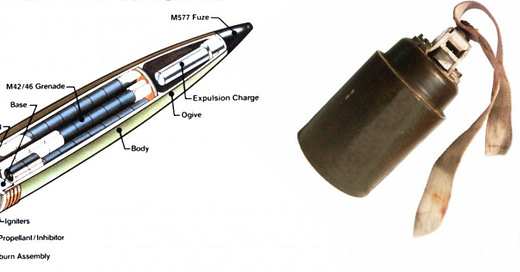Biden, the Blob, and cluster munitions
Plus: More Timothy Snyder trash talk, the Elliott Abrams atrocity, MSM catches up to NZN, Finland’s climate change “game changer,” the world’s most neglected crisis, and paid subscriber perks!
Each of the M864 artillery shells being sent to Ukraine contains 72 “grenades” that disperse over an area of roughly 5 acres before exploding.
Update-7/9/23: The New York Times now reports that the “dud rate” of the cluster munitions being sent to Ukraine may be much higher than the rate claimed by the Pentagon—the rate assumed when this piece was written.
The Biden administration said this week that it will send cluster munitions to Ukraine. Cluster munitions—which spew dozens of bomblets over a large area and are notorious for maiming or killing children who pick up “dud” bomblets years after a conflict ends—are banned by an international convention that most nations, but not the US, have signed.
And use of these particular cluster munitions is banned under US law because their “dud rate” exceeds one percent; according to Pentagon tests, the average artillery shell being sent to Ukraine will include, among its 72 bomblets, two that fail to explode upon deployment. The Washington Post said Biden will somehow “bypass” this law.
Though it’s not known how many of these shells are being sent, the Ukrainian army has fired an average of several thousand artillery shells per day over the past year. According to Human Rights Watch, Ukraine, drawing on Soviet-era stockpiles, has already used cluster munitions, and Russia has used them, too.
Biden’s decision—which comes after months of deliberation and after weeks of Ukraine’s long-anticipated counter-offensive failing to gain momentum—makes this week a good time to ask: What forces shape American discourse about how much weaponry, and which kinds of weaponry, to send Ukraine?
Here’s part of the answer: Money from arms makers. That’s the upshot of a report released by the Quincy Institute for Responsible Statecraft last month. Its author, Ben Freeman, writes: “[T]he vast majority of media mentions of think tanks in articles about US arms and the Ukraine war are from think tanks whose funders profit from US military spending, arms sales and, in many cases, directly from US involvement in the Ukraine war.”
And he’s got the receipts:
Planet Earth set a record for hottest day in recorded history on four consecutive days this week. As climate change intensifies, so does the appeal of alternatives to fossil fuels. Nuclear power, for example, starts to look better—until you get to the part about disposing of the nuclear waste.
Finland to the rescue! In BBC Future, journalist Erika Benke reports on Finland’s “Geological Disposal Facility,” which is being built 1,500 feet underground, in the bedrock beneath a small island. Under construction for 20 years, the vault is scheduled for completion in another two years, after which filling it will take an estimated 100 years.
The International Atomic Energy Agency has called the facility a “game changer.” Its radioactive contents, scientists say, will be safely isolated for at least 100,000 years. Well, they’d know better than we would (we hope). And after 100,000 years, our AI overlords will know better than we what to do with the waste next.
Attention NZN members! This week we bring you two paid subscriber perks:
1. Early access to Bob’s conversation with Nikolay and Kirill of the Russians with Attitude podcast, which over the past 18 months has become famous, and in some circles infamous, because its hosts are Russians who support the Ukraine invasion. You can access that conversation here or look for it in your paid subscriber podcast feed. On Tuesday the first hour of it will be publicly available, though the final 50 minutes will still be available to paid subscribers only.
2. The latest edition of the Parrot Room, the conversation between Bob and Mickey Kaus that airs every week after their public podcast.
We’re considering a new motto for the newsletter: “NZN—tomorrow’s MSM punditry today!”
Two weeks ago we argued that (a) Cuba’s strengthening ties with China are largely a product of America’s economic punishment of Cuba for not being a liberal democracy; and (b) more broadly, framing US foreign policy as a global struggle between autocracies and democracies is a self-fulfilling prophecy: The more we sanction and otherwise confront autocracies, the more they band together into what may look like an ideological brotherhood but is in fact cemented more by common American enmity than by ideological affinity.
Then this week, writing in the New York Times, Peter Beinart used the Cuba-China example to argue that “Washington has helped create the very anti-American partnerships it now bemoans,” and that it’s a mistake to see America’s geopolitical challenge as a struggle “between freedom and tyranny.” He invokes (again, in concert with NZN) Iranian-Russian military cooperation as exhibit B.
Beinart (whose newsletter is very much worth reading) valuably reminds us that these counterproductive policies echo policy mistakes from early in Cold War I. During the Truman years, by treating Ho Chi Minh’s rebel movement as an implacable ideological foe, we drove Ho into China’s arms; and we repeated that exercise with Cuba, driving it into Soviet arms a decade later.
And the rest, as they say, is history, a history that the Biden administration—to judge by its policy toward Cuba, Venezuela, Syria, Iran, and some other countries—seems not to comprehend.
NZN has taken to handing out cognitive empathy awards to people who work hard to understand the perspective or world view of people on the other side of some tribal divide. This week we instead recognize someone who seems to work not hard at all toward that goal.
And the winner of our first cognitive empathy failure award is…










